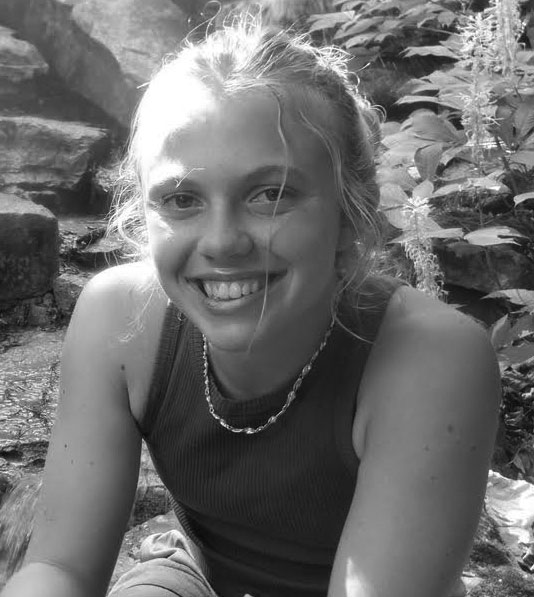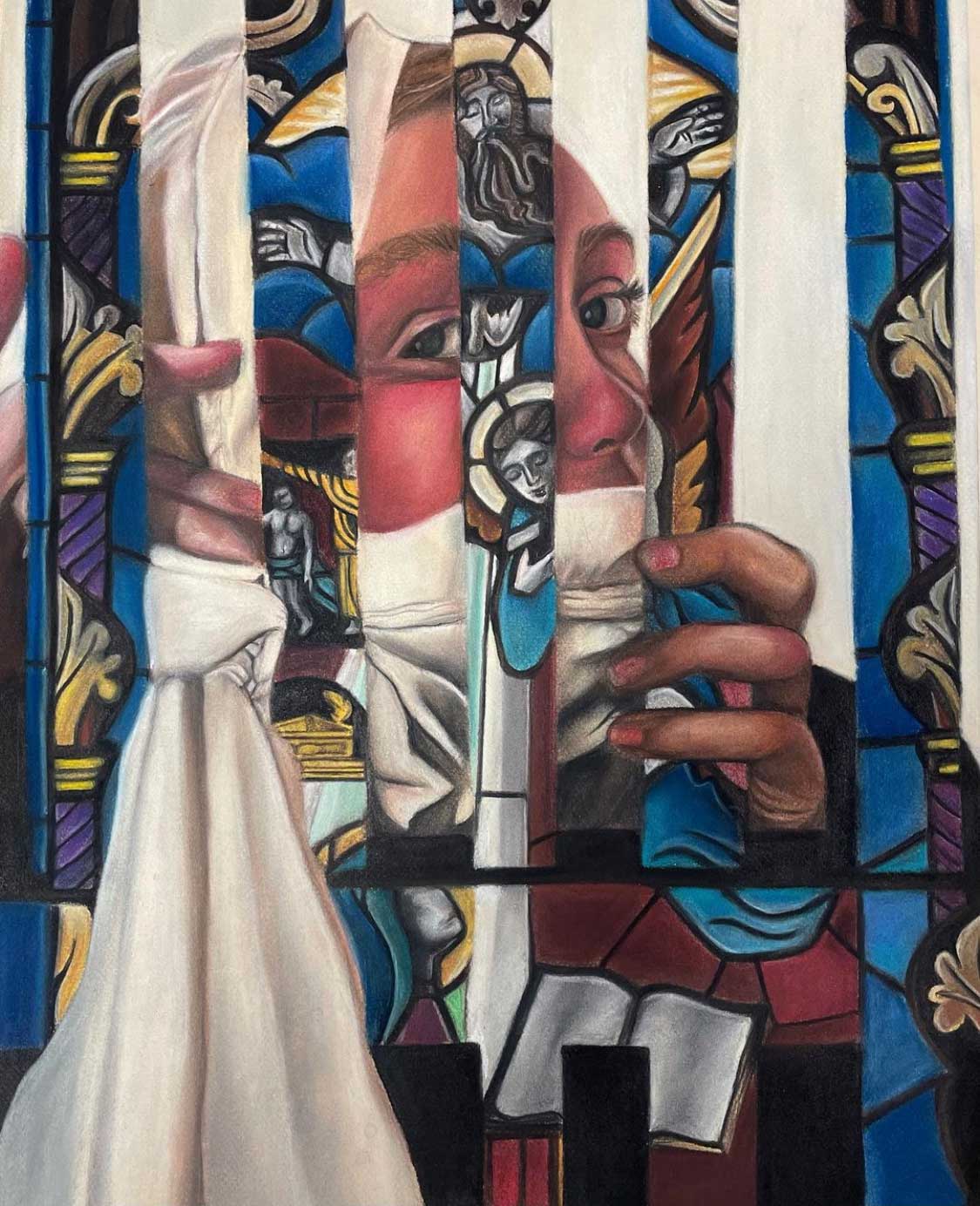


AP Drawing
Baylie Simon
Keller High School|Keller, Texas


Dimensions: 24”x 20”|Materials: Pastels|Processes: The flatness of bars creates a logical perception of depth with the figure in the background.|Curatorial Note: Contrasting colors, patterns, and expressive pose create a symbolic portrait of interior emotional space.
Student statement
Student statement
The Message Behind Trapped
"Trapped" represents the isolation and sadness experienced when one is not welcome in a religious space. The Bible says that we are all equals under the eyes of the Lord, yet many of those who preach that message see homosexual people as less than. Even if Christians say they love all people, their actions do not always show it. I have close friends who have left their church due to the homophobic attitudes of leaders and fellow attendees. None of them wished to remain in an environment where they had to pretend to be someone they were not. They did not feel safe. All people deserve to be loved without feeling ashamed of what they cannot control. I made this piece to reach those who feel unworthy of God’s love. I want them to know that they are not alone in this feeling. I also made this piece to make Christians aware of the barrier they created that separates people from experiencing the presence of God. It is not any mortal human’s place to judge others for their sins or to add more weight to specific sins that do not align with a personal set of beliefs. Everyone should be and feel welcome.
My Advice to Future AP Art and Design Students
When I was making my portfolio, I was learning how to process my emotions and chose to focus on the feeling of vulnerability. With so much weighing on my heart—I had endless feelings to explore, process, and understand. I grew with each piece in my portfolio as I learned more about myself and from new experiences. My advice to other aspiring young artists is to allow your portfolio to your viewers on a path in your life’s journey. Let it evolve as you evolve. Our artwork illustrates and creates a doorway into our everyday lives. Falling in love with that aspect of expression changed everything for me. I would encourage all future AP Art and Design students to be in tune with their thoughts and emotions so that it shows in the work they produce.
TEacher statement
TEacher statement
Craig Gould
As a lifelong learner, I have spent years trying to understand what differentiates good artists from great artists. In that pursuit, I started the Art Sense podcast in June 2021 to gather firsthand information from the world’s leading artists, critics, curators, and authors. Through more than 120 one-on-one conversations, I’ve garnered insights and commonalities from some of the world’s most creative visual artists, including Wolfgang Tillmans, Shepard Fairey, and Shirin Neshat. Based on these conversations, I have found several principles I encourage my students to consider in their sustained inquiry.
Great artists make personal work. No two people have the same story to tell, so I encourage my students to consider their identities carefully. What makes a person unique? What experiences, loves, conflicts, traumas, and relationships contribute to a person’s identity? Some artists spend their entire careers thinking about a particular place that is personal to their narrative. To successfully draw from personal experience, one must be willing to be vulnerable. I explain to my students that viewers do not judge artists for the baggage they share but rather create a strong emotional connection to the art by finding commonality with shared conflicts. We can see evidence of this investigation of identity in Baylie’s work.
Great artists carve out space for play in their creative process. In my conversation with William Kentridge, he described his attempt to separate “artist as creator” from “artist as critic." He asks “artist as creator” to approach the work with no preconception, free to explore mark-making instinctually. Only after a period of uninhibited play (something akin to a large-scale form of doodling) does he step back and ask the “artist as critic” to judge what is or isn’t working in the piece. The process of play allows the artist to access a level of subconscious creativity that can otherwise be difficult to achieve.
For great artists, nothing is too sacred. There has to be room to revise ideas and experiment with materials at the expense of comfort. I encourage risk-taking by encouraging my students to take high-quality photographs throughout the development of their pieces. If the student goes a step too far, I can print a high-quality version of the piece from before the wrong turn. The student can then try again. Sometimes, the student prefers to push boundaries on top of a high-quality print instead of continuing to push boundaries on the original artwork. Either way, the goal is to venture into uncharted territory.
Students like Baylie are willing to challenge themselves in every class and are open to change. Like my very best portfolio students, her materials, techniques, and artistic vision continued to evolve. We couldn’t have foreseen the beauty of the end product at the beginning of the process. Such is the description of a life well lived.
I enjoy my independence and being myself; however, my fear of judgment makes it hard to be who I am. These reservations impact my relationships with others as I can never fully reveal my true emotions, fearing that none (positive, neutral, or negative) are acceptable or relatable to others close to me.
Principal statement
Principal statement
Lisa Simmons
Keller High School is proud to have a long-standing tradition of excellence in our fine arts programs—fostering creativity and artistic expression while providing a platform for our students to explore and communicate through various mediums. One of my personal beliefs is that students are more successful in their academics when they have opportunities to be involved in courses and extracurricular activities about which they are passionate. School then becomes more than just a place to get an education; it is somewhere students feel valued and part of a greater community. Our visual arts programs are vital to our academic environment, creating countless opportunities for students to explore their passion for learning.
Because of the supportive, collaborative community created by Mr. Gould and our art teaching team, the Keller High arts programs are thriving. It all starts with building relationships and creating a safe space for students to allow their creativity to flow. Our educators capture students early in high school to instill a strong desire to continue down the visual arts pathway, taking advanced courses. This environment builds self-confidence and provides a place where failing or making a mistake is an opportunity to create something new. Our art teachers are all artists and do a great job using their passion for the arts to produce multiple avenues for students to develop and use their unique talents to grow as individuals and artists.
From a leadership standpoint, ensuring our arts programs are funded and providing opportunities for students to showcase their work on campus and in our community is critical to continued success.
I am incredibly proud of Baylie. Her growth as a student and her artistic abilities certainly set her apart, and I am grateful for Mr. Gould and his ability to provide a space where students are free to create and collaborate!
Baylie Simon



